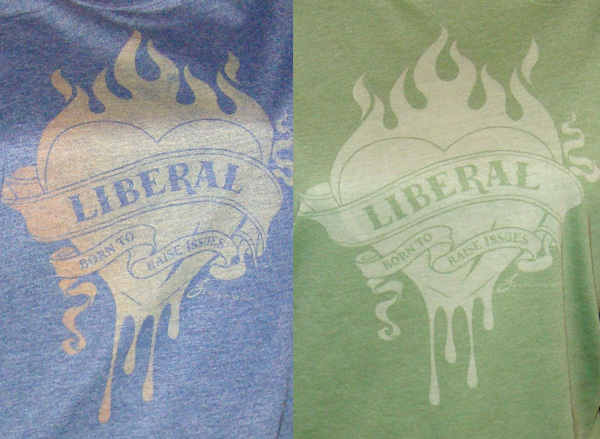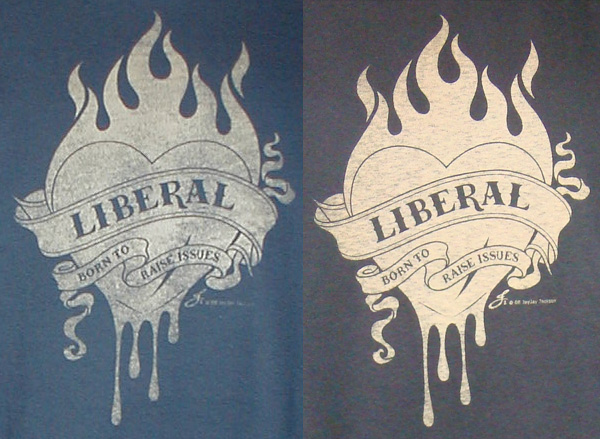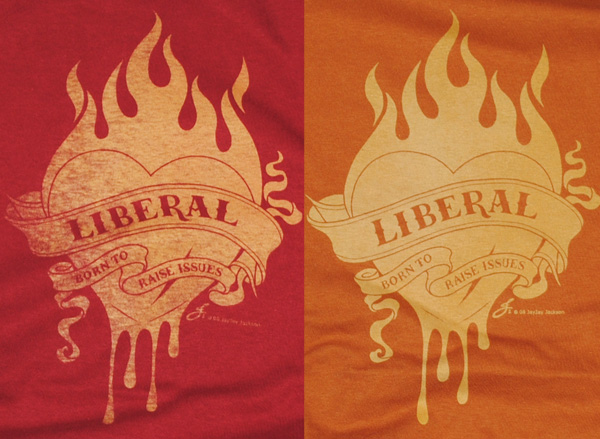I had also found this stuff, “Discharge Paste” and the description said “Discharge Paste does not always remove all of the color, it depends on the dye and the color to which it is applied.” That intrigued me. Sounded like potential trouble, but intriguing trouble. It doesn’t work like the discharge ink which removes the color from the shirt and replaces it with another color. The discharge paste just removes the color the shirt fabric was dyed with, taking the design back to something like the raw color of the fabric before dyeing. Though it doesn’t work on all dyes or all colors.
Decent quality shirts like Hanes, Anvil, Jerzees, Bella, etc. work the best. Most of the colors will discharge well, but we’ve had trouble with a few colors like Royal Blue, not all the blues, just Royal. Shirts that are the “Pigment Dyed” type don’t seem to discharge very well, though sometimes you can use that as an effect. Another cool effect is to use discharge on a 50/50 cotton/poly blend. Only the cotton fibers discharge, giving the design a kind of distressed or slightly speckled look. At the end I’ve put some pictures of shirts we’ve done with discharge paste.
Using the paste is easy. Here’s what the Dharma web site says “It is fairly safe to use, the main byproduct being ammonia. It is for natural fibers and unlike bleach, it doesn't damage them.” It doesn’t have to be mixed, you use it right out of the container. Doesn’t even need to be thinned with water. It has an odd consistency, sort of gloopy, to use the technical term. Freddy says it’s like snot. It’s water based, so you do need to back flood while you are screening to keep the paste from drying in the screen. Back flooding is when you lightly pull (or push) the squeegee across the screen to lay down a layer of ink that sits on top of the design to both lay ink down on the design for the next print stroke and also to keep a water based ink from drying in the screen.
The gloopy paste:

Here’s a picture of a back flood stroke.

You screen the paste onto a shirt, let it dry and then iron it with a steam iron. An iron that puts out a lot of steam is best. I’ve tried 3 or 4 different irons, but the one we always use is an old iron my dad gave me when I left home. It’s beat up, but still works the best, as long as we clean it regularly. We fill it with water, put it on the cotton setting and iron the design and it appears like magic. It is a bit smelly and it does leave an odor on the shirt until it’s washed. We usually air the shirts out before we deliver them or ship them.
Here's what the shirt looks like when screened. You can barely see the design.

Here is what it looks like as you iron it. Magic!

Here's a closeup of the print. Three years later it still looks great:

Here are some different shirts we’ve screened with the Discharge Paste. Each one comes out a little different, depending on how you screen it and the color of the shirt. To get the varying degrees of distressing we vary the squeegee pressure slightly. The same screen was used for all of these. We love the unpredictable results and the naturally distressed effect. By far the most popular ones are the more distressed shirts. More examples of what we do can be found on the Deaths Head Designs web site.
Two red 100% cotton shirts, but different brands:

Bella Women's 50/50 Heather Jersey shirts:

A navy blue and a black shirt, both 100% cotton:

A grey Gildan Ultra and an Anvil black spaghetti strap, both 100% cotton:

A cardinal red Gildan Ultra and a burnt orange Hanes Beefy T:

Also, here is a very informative video by Catspit Productions that explains different methods of pull or push strokes and flood strokes. This video is demonstrating with Plastisol ink, however, which is a bit different than the water based inks we use.
More of these videos are on Catspit on youtube:
Next: Top Tips
I just got some paste to play with myself! Your article was very helpful in deciding whether I could run it through a screen or not!
ReplyDeleteDoes the past have to be ironed or can you set with a heat gun?
Thanks!!
I'm thinking of trying to tint my discharge paste with dye. Has anyone out there tried it?
ReplyDeleteI know industrial shops do it but I'm going to try to DIY.
I have a ton of experience with discharge printing & dyeing but have never tried to combine the two.
Hi Loca,
ReplyDeleteI want to try that too. I bought the EnviroMAX Gallon Water Base & Discharge Ink Mixing Kit & System from http://www.silkscreeningsupplies.com/product/MTPCMAXGAL, but I've only used it a couple of times, which isn't enough to really judge the product. More soon, I hope.
One of my upcoming projects is to use discharge paste on black shirts and then hand paint dyes into the discharged areas.
Dear Barkdecor,
ReplyDeleteWe always use an iron. That's what it says to do, so we do. But we have had much better results with an old iron that puts out a LOT of steam.